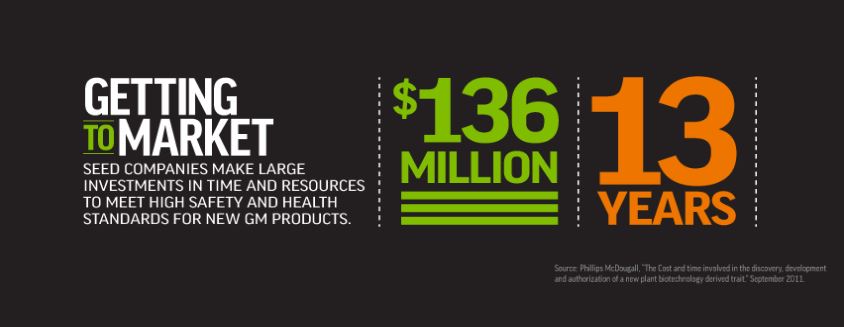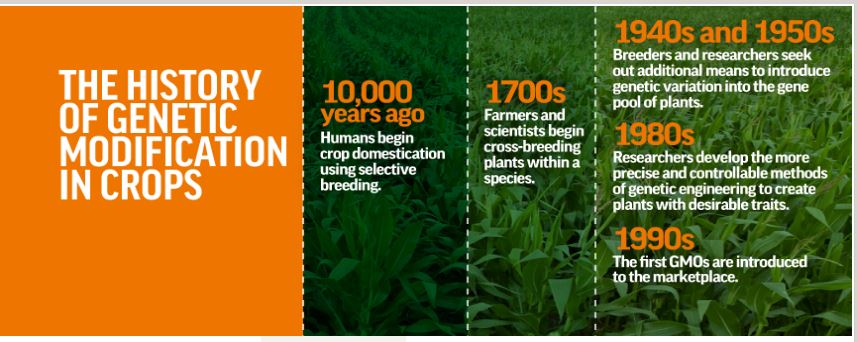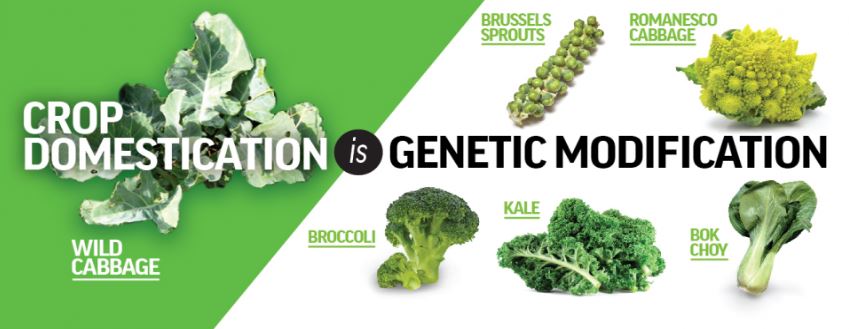GMO Facts
Learn more at GMO Answers.
ISAAA Brief 51-2015: TOP TEN FACTS about Biotech/GM Crops in their First 20 Years, 1996 to 2015
http://www.isaaa.org/resources/publications/briefs/51/toptenfacts/default.asp
Benefits of Biotechnology/GMOs
Genetically modified (GM) technology incorporates desirable traits from nature into crops, resulting in plants that can be healthier, more nutritious, and better for the environment. This process is done without introducing anything unnatural or using chemicals.
Shrinking our Environmental Footprint
- GMOs enable farmers to be better stewards of the environment, allowing farmers large and small to grow more crops on less land while using fewer pesticides and less water.
- In the United States, the adoption of GM crops resulted in pesticide use reduction of 46.4 million pounds in 2003. Globally, GM crops have reduced pesticide spraying (1996-2011) by 9%, or 975 million pounds.
Lowering the Price of Food
- Because they require fewer pesticides, land and water, GMOs help keep food production costs down resulting in lower prices for consumers. GM technology helps reduce the price of crops used for food, such as corn, soybeans and sugar beets by as much as 15–30%. Mercaris, a market data researcher, found that 2013 prices for non-GMO corn averaged 51 cents per bushel higher than GMO corn.
Alleviating Hunger and Malnutrition Around the World
- GMOs have helped feed more than 300 million Americans and a global population of 7 billion—of which 1 in 8 suffer from hunger and malnutrition.
- By 2050, the global population is expected to rise to 9 billion. Experts predict we will need 70% more agricultural production to keep pace #8212;utilizing GM crops that increase productivity while reducing land, water, and pesticide use will be critical to this achievement.
What are GMOs?
Biotechnology in plant agriculture has come to mean the process of intentionally making a copy of a gene for a desired trait from one plant or organism and using it in another plant. The result is a GMO (genetically modified organism).
What's in a name? GMO, genetic modification, biotechnology, biotech seeds, genetic engineering
Genetically modified organism (GMO) is commonly used to describe any of the terms above, but actually means that a change has been made to the DNA of an organism.
Why do farmers use GMOs?
Farmers choose seeds based on what is best for their farms, market demand and local growing environments. Farmers select GMOs to reduce yield loss or crop damage from weeds, diseases, and insects, as well as from extreme weather conditions, such as drought. Farmers choose to use GMOs to reduce the impact of agriculture on their environment and their costs — by applying pesticides in more targeted ways, for example. Farmers have also used GMOs to save a crop – such as papaya from Hawaii — that was being threatened by a disease.
Where are GM crops grown in the world?
Farmers around the world have chosen to use GMOs because of the benefits to their businesses and their local communities. As of 2014, GMOs are grown, imported and/or used in 70 countries.
How many crops are genetically engineered?
There are currently nine crops commercially available from GMO seeds in the US: Alfalfa, Canola, Corn (field and sweet), Cotton, Papaya, Potatoes, Soybeans, Squash, and Sugar Beets. One more, GMO apples, is approved and coming to market soon.
1.2 Billion lbs.
The reduction in pesticide applications from 1996-2013 as a result of GMOs, which has saved farmers time and money, while reducing their environmental footprint.

Did you know?
Plant varieties developed from other breeding techniques, including thousands of conventional varieties and those used in organic production systems have been developed using mutagenesis and do not go through any formal regulatory assessment to evaluate environmental or food safety that GMOs do.
Extensively Researched and Studied
Before they reach the market, crops from GM seeds are studied extensively to make sure they are safe for people, animals and the environment. Today’s GM products are the most researched and tested agricultural products in history.
Precise Understanding of Plants
When creating a GMO, researchers copy specific genetic information from one plant or organism and introduce it into another to improve or enhance a specific characteristic or trait, such as resistance to insects.
The researchers characterize very precisely what change they are making to the plant's genome, and how it will impact the metabolism of the plant cells. The plants are then extensively tested in the greenhouse and field, andresearchers look for any difference between the GM plant and conventional plants. Plants grown in the field across a range of environments are also harvested and analyzed for their compositional makeup.
The Same as Other Crops
Biotech crops currently available on the market are the same from a compositional and nutritional standpoint as their non-GM counterparts, for example, GM corn is the same as non-GM corn. Testing has shown and FDA review has confirmed that GMOs are nutritionally the same as non-GM crops, including the same levels of key nutrients like amino acids, proteins, fiber, minerals and vitamins.
No Links To Diseases
Food from GMOs is digested in the body the same as food from non-GM crops. Hundreds of studies have and continue to demonstrate that GMOs do not present any health risk—they do not cause new allergies or cancers, infertility, ADHD or any other diseases. In the years that farmers have grown crops from GM seeds (since around 1994), there has not been a single documented instance of harm to human health resulting from genetic modifications, including new allergic reactions.
The evolution of crop improvement — Building on genetic diversity
Farmers have intentionally changed the genetic makeup of all the crops they have grown and the livestock they have raised since domestic agriculture began 10,000 years ago. Every fruit, vegetable and grain that is commercially available today has been altered by human hands, including organic and heirloom seeds.
In the late 20th century, advances in technology enabled us to expand the genetic diversity of crops. For years, university, government and company scientists intensively researched and refined this process. A major result has been GM seeds that maintain or increase the yield of crops while requiring less land and fewer inputs, both of which lessen the impact of agriculture on the environment and reduce costs for farmers.


Humans created today’s corn crop
Over the past century, corn has evolved with the availability of hybrid corn in the 1930s and the planting of GM crops in the mid-1990s. Due to the insect resistance and/or herbicide tolerance of GM corn, more and more of it was planted. Contrary to popular belief, the development and increased usage of GM corn has not changed the physical appearance of corn.
What has changed, due to modern plant breeding, is size, consistency, seed performance, yield, the number of ears per stalk, and the position of the ear and the leaves on the stalk. Currently, a plant has only one ear located about waist high (the height of a combine blade), and its leaves grow at a more upright angle to better catch sunrays and rain. A century ago, farmers planted about 8,000 corn plants per acre. Today they plant about four times as many plants per acre.
Key Research and New Seed Development
Companies, academic researchers and government scientists are working on new GMOs in key areas. These emerging developments present expanded potential for GMOs.
Improving Environmental Stewardship - Adapting to Challenging Conditions
Examples:
GM
drought tolerant corn in the US (this is fully approved in the US and beginning limited commercial testing this year)
Corn seeds that require
less nitrogen, a fertilizer that can be costly to farmers and can have environmental impacts
Improving Nutrition
Examples:
- Golden Rice that includes B-Carotene to deliver vitamin A to children in developing nations
- Pineapple with lycopene, which may help prevent lung and prostate cancer
- EPA/DHA Omega-3 oils from canola oil, which are scientifically proven to prevent heart disease and enhance cardiovascular outcomes
Plant Disease Resistance
Examples:
- A genetically modified American Chestnut tree that can withstand the blight that decimated the species in the 20th century, nearly wiping out a highly valued hardwood tree that was once prevalent in the eastern part of the country
- Fungal resistant grapes which may enhance resistance to mildew and other fungal diseases
Improved visual appeal to reduce waste
Example:
Apple varieties that have been enhanced through biotechnology so they don't brown.
What is a GMO? The following video explains how GMOs are made and their role in modern agriculture from the Genetic Literacy Project.